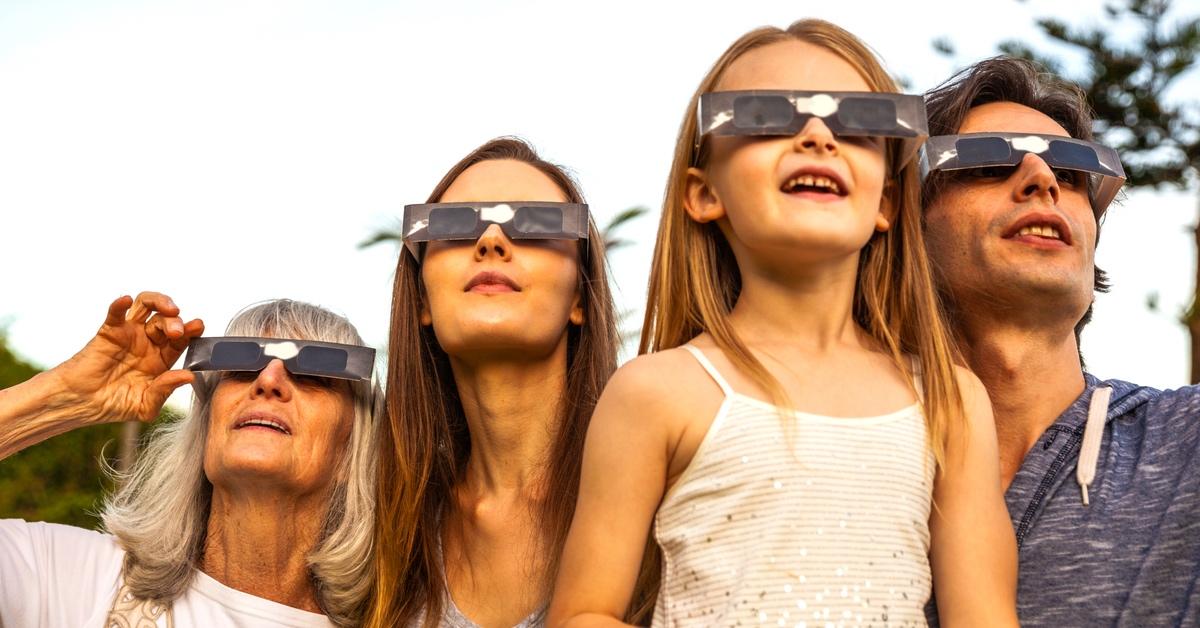Safely Watch the Solar Eclipse at Home by Building Your Own Solar Eclipse Glasses
For a lunar eclipse, you don't need protective eyewear for viewing, but for a solar eclipse, you'll need specialized glasses to see the sun.
Published March 13 2024, 11:15 a.m. ET

Of the many mysteries of the universe, a solar eclipse is a spectacular phenomenon to witness — as long as you do so safely. According to NASA, "Viewing any part of the bright Sun through a camera lens, binoculars, or a telescope without a special-purpose solar filter secured over the front of the optics will instantly cause severe eye injury." So, if you're interested in viewing the eclipse, you must purchase or build your solar eclipse glasses.
Thankfully, building eclipse glasses is a low-cost activity that will also provide the safety you need! Here are a few easy steps to build your own solar eclipse glasses, plus, how you can view the eclipse without them.

Here's how to make your own eclipse glasses for the solar eclipse.
According to Instructables, to make your own eclipse glasses, you need only a few household items and a template. First, gather a pen, scissors, a template for your glasses (such as the one located here), a roll of painter's tape, a solar filter, and poster board or card stock.
If you want to make things easier on yourself, you can repurpose old 3-D glasses from the movies by popping out the lenses and replacing them with a solar filter.
Additionally, you'll want to ensure your solar filter is legitimate — there are only a few places that carry ISO-certified solar filters, such as Rainbow Symphony.

If you're making glasses from scratch, trace the template you printed onto cardstock and cut it out. The result should resemble rectangular glasses with two frames and handles around the ears.
Next, measure and cut out the solar filter so it fits over your glasses' eye holes. Be extremely careful during this process, as any damage to the solar filter can alter its protective qualities.
Finally, tape the solar filter over the eyes of the glasses and the earpieces into place, and there you have it! Your very own solar eclipse glasses.
To test the efficiency of your glasses, go to a dark room and have someone shine a flashlight at you. If any light comes through that isn't a yellow or orange hue (due to the solar filter), you have a leak, and you will have to repeat the process with a new piece of solar filter.
If the concept of glasses isn't your style, you can also create a solar eclipse viewing device following the steps laid out by LiveScience. Creating a solar eclipse viewing device does not require purchasing solar filters, so it might be slightly more cost-efficient.

Can you see the eclipse without glasses?
It's important to note that you do not need eclipse glasses to view a lunar eclipse, such as the lunar eclipse on March 25, 2024.
According to the American Academy of Ophthalmology, a lunar eclipse makes the moon "invisible" to humans on Earth because no light rays are reflected off the moon. So, "even when looking at the moon immediately before or after the eclipse, the reflected light off the moon does not have the same potential for damage as during a solar eclipse."
You can see the solar eclipse without glasses while using a solar eclipse viewing device or by putting a solar filter on your camera, binoculars, or telescope.
However, NASA warns eclipse enthusiasts that you should not use a camera, binoculars, or a telescope to view the solar eclipse without solar filters, which differ from the kind you would use for your DIY glasses.